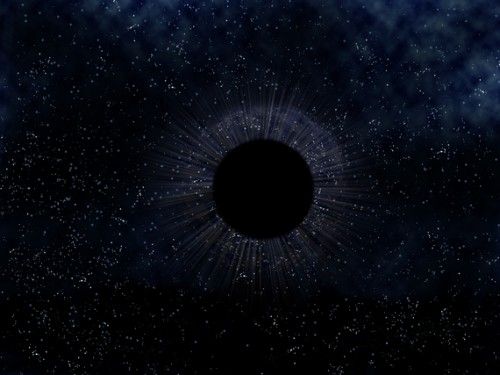In 1933, the Swiss astronomer Fritz Zwicky made a discovery that left the world speechless: there was, claimed Zwicky, substantially more matter in the universe than we can actually see. Astronomers called this unknown matter "dark matter", a concept that was to take on yet more importance in the 1970s, when the US astronomer Vera Rubin called on this enigmatic matter to explain the movements and speed of the stars. Scientists have subsequently devoted considerable resources to identifying dark matter - in space, on the ground and even at CERN - but without success. In 1998 there was a second thunderclap: a team of Australian and US astrophysicists discovered the acceleration of the expansion of the universe, earning them the Nobel Prize for physics in 2011. However, in spite of the enormous resources that have been implemented, no theory or observation has been able to define this black energy that is allegedly stronger than Newton's gravitational attraction. In short, black matter and dark energy are two mysteries that have had astronomers stumped for over 80 years and 20 years respectively.
A new model based on the scale invariance of the empty space
The way we represent the universe and its history are described by Einstein's equations of general relativity, Newton's universal gravitation and quantum mechanics. The model-consensus at present is that of a big bang followed by an expansion. "In this model, there is a starting hypothesis that hasn't been taken into account, in my opinion", says André Maeder, honorary professor in the Department of Astronomy in UNIGE's Faculty of Science. "By that I mean the scale invariance of the empty space; in other words, the empty space and its properties do not change following a dilatation or contraction." The empty space plays a primordial role in Einstein's equations as it operates in a quantity known as a "cosmological constant", and the resulting universe model depends on it. Based on this hypothesis, Maeder is now re-examining the model of the universe, pointing out that the scale invariance of the empty space is also present in the fundamental theory of electromagnetism.
Do we finally have an explanation for the expansion of the universe and the speed of the galaxies?
When Maeder carried out cosmological tests on his new model, he found that it matched the observations. He also found that the model predicts the accelerated expansion of the universe without having to factor in any particle or dark energy. In short, it appears that dark energy may not actually exist since the acceleration of the expansion is contained in the equations of the physics.
In a second stage, Maeder focused on Newton's law, a specific instance of the equations of general relativity. The law is also slightly modified when the model incorporates Maeder's new hypothesis. Indeed, it contains a very small outward acceleration term, which is particularly significant at low densities. This amended law, when applied to clusters of galaxies, leads to masses of clusters in line with that of visible matter (contrary to what Zwicky argued in 1933): this means that no dark matter is needed to explain the high speeds of the galaxies in the clusters. A second test demonstrated that this law also predicts the high speeds reached by the stars in the outer regions of the galaxies (as Rubin had observed), without having to turn to dark matter to describe them. Finally, a third test looked at the dispersion of the speeds of the stars oscillating around the plane of the Milky Way. This dispersion, which increases with the age of the relevant stars, can be explained very well using the invariant empty space hypothesis, while there was before no agreement on the origin of this effect.
Maeder's discovery paves the way for a new conception of astronomy, one that will raise questions and generate controversy. "The announcement of this model, which at last solves two of astronomy's greatest mysteries, remains true to the spirit of science: nothing can ever be taken for granted, not in terms of experience, observation or the reasoning of human beings", conclued André Maeder.

For close on a century, researchers have hypothesised that the universe contains more matter than can be directly observed, known as "dark matter". They have also posited the existence of a "dark energy" that is more powerful than gravitational attraction. These two hypotheses, it has been argued, account for the movement of stars in galaxies and for the accelerating expansion of the universe respectively. But - according to a researcher at the University of Geneva (UNIGE), Switzerland - these concepts may be no longer valid: the phenomena they are supposed to describe can be demonstrated without them. This research, which is published in The Astrophysical Journal, exploits a new theoretical model based on the scale invariance of the empty space, potentially solving two of astronomy's greatest mysteries.




